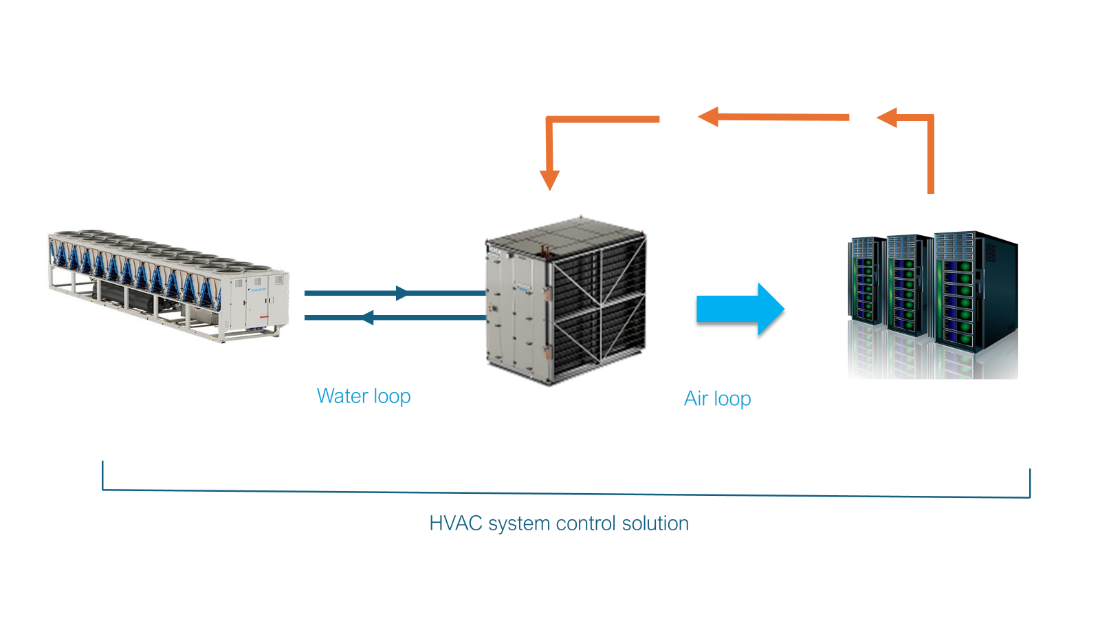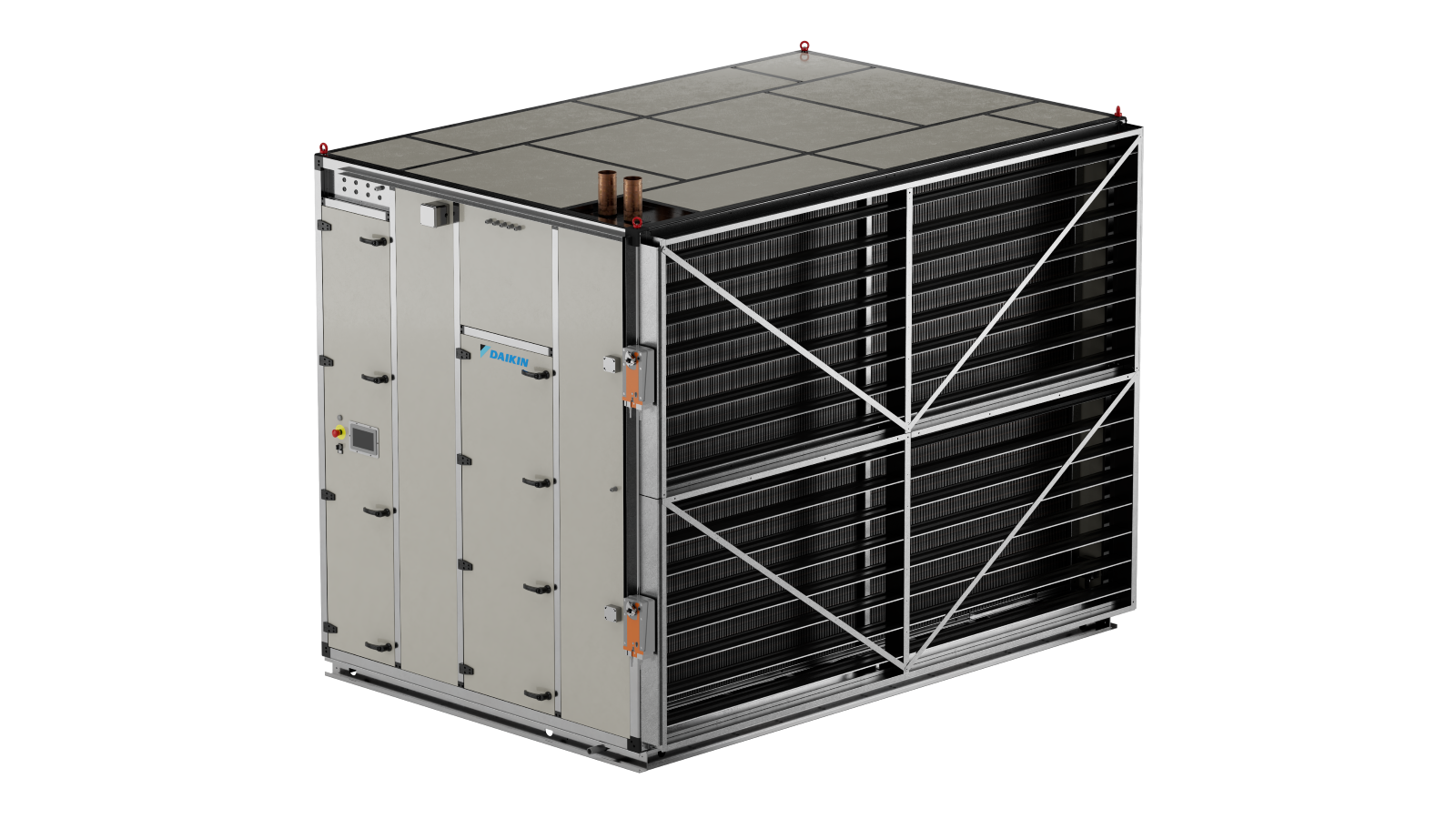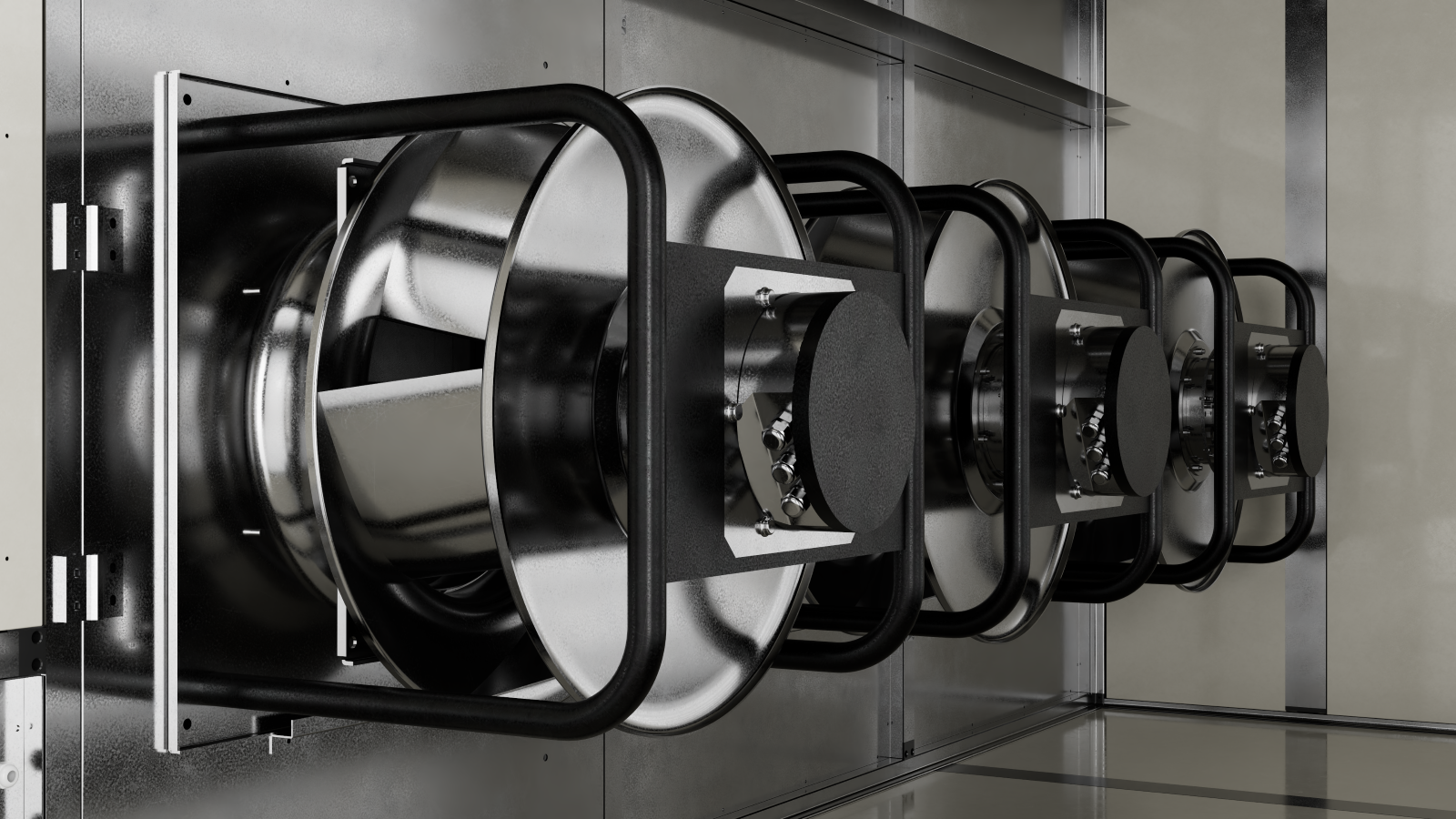The global data center market is large and growing rapidly, with approximately 10,978 data centers worldwide, while data centers currently account for 1.3% of global electricity consumption. In this context, it is imperative to prioritise sensible design choices for data centers, with a focus on improving energy efficiency to reduce CO2 emissions. A key aspect of reducing the environmental footprint of digital infrastructure is to optimise cooling systems, which typically account for 30% of data center energy consumption.
Overview of a data center cooling system

The schematics above describe a typical HVAC plant for a data center, and introduce the main elements of Daikin’s solution, including several components:
- Air-to-water free cooling chiller
- Computer Room Air Handling (CRAH) unit
- Control systems
- After-sales services
Among the main elements of a typical Daikin data center HVAC system, this article will focus on Computer Room Air Handling (CRAH) units and the main challenges faced when selecting this equipment within the cooling system design.
Challenge #1: identify the appropriate equipment for installation space availability
As in every application, the space allocated to HVAC equipment in data centers is limited. Therefore, it is crucial to evaluate alternatives concerning units’ dimensions and related cooling capacity.
Reason #1: Daikin Pro-W, our range of CRAHs, is flexible and scalable. This results from a modular design approach, allowing further redundancy of capacity and easiness of maintenance activities. Pro-W units can be stacked or positioned directly against each other, without compromising the airflow required for efficient cooling. Pro-W units are available in four sizes, covering from 175 to 700 kW cooling capacity in a single unit to provide a compact solution in large to hyperscale data center installations.

Challenge #2: how to keep operating costs low and raise PUE
Given the significant size of the operations, the need to prioritise strategies to maintain low operating costs becomes imperative. This is linked to the need to reduce the environmental footprint of the various facilities.
The efficiency of an air-cooling system depends on several key factors, each contributing to its effectiveness in different applications. An overview of the main strategies to optimize an air-cooling system is provided here below:
- Use EC fans
- Ensure adequate water velocity at part load and high delta T conditions
- Employ pressure-independent control valves (PICVs) to stabilize water flow
- Implement control solutions to raise system efficiency
- Reducing harmonic distortions
- Optimizing power factor to minimize losses
Adjusting cooling capacity to data hall demand
Matching the cooling load to the data center's needs means dynamically responding to variations in the heat load generated by server activity and associated equipment. This targeted approach maximises energy efficiency by minimising waste and optimising units’ working conditions based on actual operational requirements. This approach can be pursued with a series of solutions, described here below.
The first level of consideration relates to, of course, the kind of fans assembled onto the air handling unit.
Reason #2: Daikin EC fans, motor class IE5 for high efficiency and low power consumption. The use of electronically commutated motors offers higher energy efficiency than traditional motors. Hence, the use of these fan motors reduces operating costs and environmental impact. On top of that, Daikin EC fans are equipped with aluminium impellers, resulting in a more robust design concerning composite impellers.

Reason #3: Still on how to improve efficiency, it is preeminent to ensure efficient operation at part load and high delta T conditions. In these cases, it is crucial to ensure adequate water velocity, focusing exclusively on sensible heat exchange. Daikin properly handles this challenge as the circuiting of its water coil has been optimized for this purpose. This optimisation has a direct impact on the efficiency and effectiveness of the cooling system, especially in scenarios where the temperature differential is significant. In addition, the thick aluminium fins used for the water coil of the Pro-W as a standard, ensure more robustness and longer lifetime, as data centers are working 24h non-stop.
Proper management of the water flow also impacts total air-cooling equipment running time and therefore temperature control.
Reason #4: Pressure-independent control valves can be integrated within Daikin Pro-W units, to ensure stable flow, better temperature control and lower operating costs.
Control of the whole air-cooling system to lower operating costs
Large and hyperscale data centers typically require many CRAHs, from a few dozen to hundreds. Therefore, it is crucial to keep all these units under the same control system, to exploit further opportunities to raise system efficiency and thereby PUE.
Reason #5: Daikin provides such a solution, within its Intelligent Data Center Manager (iDCM). Using iDCM, all Daikin’s data center HVAC system units are in constant communication with each other, including Primary pump management and free cooling mode. As well, iDCM uses an advanced machine learning algorithm based on manufacturer data and live data recorded in the field. iDCM can ensure an increase in system efficiency of up to 10% for mechanical cooling systems and up to 15% for integrated free cooling systems compared to standard control solutions.
Properly handle harmonic distortions
Harmonic distortions are caused by nonlinear loads such as variable frequency drives, power converters, or electronic equipment. This can cause additional power consumption in electrical systems. To overcome this, active harmonic filters (AHFs) have been developed to mitigate harmonic distortions, ensuring total harmonic distortion (THD) below 5%. They are capable of dynamically compensating for harmonic currents in real time, thereby improving the power quality of the system. As well,
AHF also optimizes fan motors’ power factor, thereby reducing energy losses.
Reason #6: AHFs can be integrated into Daikin Pro-W assembly upon demand, to limit the side-effects of harmonic distortions.
Challenge #3: choose durable and reliable equipment
The management of a data center is complex, as the main objective is to ensure continuous operation all day, every day. Therefore, the HVAC system must comply with high expectations. Indeed, a recent Uptime Institute report summarizes that 14% of downtime episodes are caused by cooling system issues. In addition to that, the causes of downtime are predictable in most cases (76%), as they are often related to human error. In this area, problems due to inadequate equipment management and maintenance are significant (36%). The reliability of CRAHs is therefore crucial for the HVAC system reliability. In this sense, 4 considerations should be made:
- Redundancy of internal design of equipment
- How control solutions support air-cooling system reliability
- Equipment protections against power failures
- The possibility to test air handlers before delivery onsite
Redundant design equals reliable design
CRAHs make sure temperature is controlled within the data hall. Their main means for this purpose are fans. Hence, special attention is to be provided on how the fan array is structured, and if redundancy would be offered to handle any fault.
Reason #7: Daikin Pro-W CRAHs are equipped with a N+1 redundant design on fans. That is, even in the unlikely event of one fan failing, the others can maintain the design airflow, making the unit's design even more robust.
The system controls support reliability management
As previously stated, whole HVAC system controls are needed within data centers. One of the reasons for this relates to the need for the system to be operational every day, all day long. Therefore, system controls would have to be capable of handling the operating time of air handlers and handling eventual downtime concerning any of the air handlers installed.
Reason #8: Daikin iDCM makes sure this requirement is satisfied. In case of failures on any of the CRAHs, iDCM regulates the operating conditions of the other units, to ensure temperature conditions of the data hall are maintained.
Equipment protection against power failures
The risk of power failure must be carefully considered when selecting air handlers. In this sense, it is suggested to include automatic transfer switches (ATS) within CRAH unit assembly.
Reason #9: ATS are included onto Daikin Pro-W standard design. On top of that, an uninterruptible power supply (UPS) capacitor is assembled into the Pro-W, to let it activate fans promptly as soon as ATS restores power supply. Full fan speed is then reached in less than one minute.
Factory acceptance testing
In critical applications such as data centers, tests are normally requested on CRAHs before their delivery.
Reason #10: Daikin offers Factory Acceptance Testing (FAT), a service involving a series of tests to ensure that the unit meets the specified requirements, design criteria, and functionality before its delivery onsite.
Challenge #4: identify manufactures capable of handling complexity
Data center projects are complex ones. Many requirements are typically raised for air handlers regarding product features, delivery times, and maintenance services. These requirements can be satisfied only by specialised manufacturers, capable of handling them and performing with the due competencies that customers expect in this sector.
Reason #11: Daikin is the world’s leading company in the air-conditioning sector, present worldwide with sales offices, product development and manufacturing facilities. In this regard, Daikin has been designing and manufacturing air-handling units in Europe for more than 50 years. To date, AHUs in European areas are designed in manufactured in two sites: Cramlington (Northumberland, UK) and Caleppio di Settala (Italy). This manufacturing flexibility results in limited transportation costs, thanks to the proximity of manufacturing concerning installation sites in Europe. Complex supplies take a consistent part of the business. Focusing on data centers, Daikin has been supplying 105 MW of cooling capacity for a single data center project in Northern Europe. The system provided was including chillers, CRAHs and the Daikin Intelligent Data Center Manager control system. Through its global presence, Daikin has an extensive service network, thereby ensuring prompt and competent service coverage for data center installations.
Do you want to know more about Daikin’s data center solutions? Then, get in touch with the form below.
